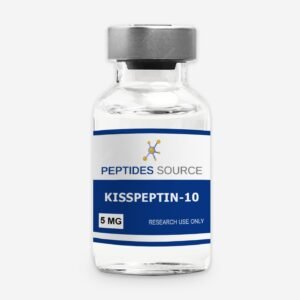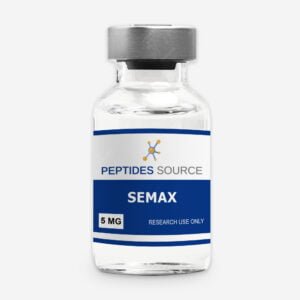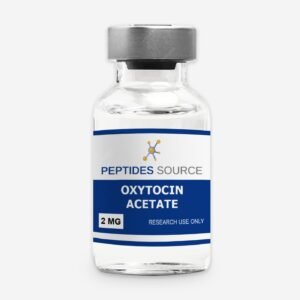- You cannot add "Tesamorelin 2mg" to the cart because the product is out of stock.
AOD 9604 5mg
$32.50 - $40.00
You save
- Physical profile: Lyophilized powder
- This product is sold as a research chemical and not for human or animal consumption. For laboratory use by qualified professionals.
Availability: Ships today if ordered and paid by 12 PM EST. (Except Saturdays & Sundays)
Product Usage
This PRODUCT IS INTENDED AS A RESEARCH CHEMICAL ONLY. This designation allows the use of research chemicals strictly for in vitro testing and laboratory experimentation only. All product information available on this website is for educational purposes only. Bodily introduction of any kind into humans or animals is strictly forbidden by law. This product should only be handled by licensed, qualified professionals. This product is not a drug, food, or cosmetic and may not be misbranded, misused or mislabled as a drug, food or cosmetic.
AOD 9604 is a synthetic peptide fragment derived from the C-terminal region of human growth hormone (hGH). It consists of amino acids 176–191 and is primarily studied for its potential fat-reducing properties without affecting blood sugar levels or promoting muscle growth. Unlike full-length hGH, AOD 9604 aims to stimulate lipolysis and inhibit lipogenesis without anabolic effects.
Introduction:
AOD 9604 is a modified peptide fragment developed from the human growth hormone (hGH) sequence, specifically residues 176–191. Initially engineered to harness the fat-reducing benefits of hGH while minimizing adverse effects, AOD 9604 has drawn considerable attention in medical and fitness communities. Human growth hormone itself plays multiple roles in the body, such as stimulating growth, cell reproduction, and metabolism regulation. However, the clinical use of full hGH is associated with a range of unwanted side effects, including insulin resistance, joint pain, and an increased risk of certain cancers. Therefore, scientists aimed to isolate the specific segment of hGH responsible for fat metabolism, leading to the development of AOD 9604.
The principal appeal of AOD 9604 lies in its ability to promote lipolysis which is the breakdown of fat , while simultaneously inhibiting lipogenesis which is the formation of new fat deposits. Research suggests that it achieves this without significantly altering blood glucose levels, making it a potentially safer alternative to traditional hGH therapy for weight management. AOD 9604 received initial patenting and development under Metabolic Pharmaceuticals in Australia, and preclinical studies indicated encouraging results related to weight loss and fat metabolism.
Despite its promise, AOD 9604 has faced regulatory challenges and mixed outcomes in clinical trials. While it has shown good safety profiles, its efficacy in large human studies remains under scrutiny. Still, its potential for therapeutic applications in obesity, metabolic syndrome, and other weight-related conditions continues to be actively explored. Beyond medical use, it has also attracted interest in the athletic and bodybuilding communities, although its legal status varies across regions. Continued research and carefully designed clinical trials are essential to establish the full therapeutic value and regulatory acceptance of AOD 9604.
Overview:
AOD 9604 is a peptide therapy primarily investigated for its unique fat-reducing actions without the broader systemic effects typical of full-length human growth hormone. Structurally, AOD 9604 mimics a small region of the growth hormone molecule (amino acids 176–191) and is designed to specifically target fat metabolism. Preclinical animal studies demonstrated that AOD 9604 could significantly decrease body fat levels, even without dietary changes, sparking enthusiasm for its therapeutic potential.
Mechanistically, AOD 9604 is believed to enhance the breakdown of stored fat (lipolysis) while simultaneously suppressing the production of new fat cells (lipogenesis). It appears to exert these effects by interacting with receptors involved in fat metabolism rather than activating the broader growth-promoting pathways associated with full-length growth hormone. Unlike many anabolic peptides, AOD 9604 does not induce increases in muscle mass or interfere significantly with glucose metabolism, reducing concerns about insulin resistance and other metabolic side effects.
Clinically, AOD9604 has undergone several trials to evaluate its safety and efficacy in treating obesity. Although it demonstrated a strong safety profile and was well tolerated by patients, its effectiveness in promoting weight loss at a clinically meaningful level remains inconclusive. Some studies reported modest reductions in fat mass, while others showed no statistically significant benefit compared to placebo. As a result, AOD9604 has not yet been widely approved as an obesity treatment by major regulatory bodies like the FDA.
Beyond obesity, there is growing interest in other potential uses for AOD9604, including healing cartilage damage, managing osteoarthritis, and enhancing recovery after injury, given some findings suggesting it may aid in tissue repair. Its application in non-medical fields, especially in sports and fitness, has also expanded, though its use is often restricted under anti-doping regulations.
Currently, AOD9604 is available in some markets as a supplement, often advertised for weight loss and body recomposition. However, it is important for users to be aware that over-the-counter formulations may not have undergone the same rigorous testing as pharmaceutical-grade products. Ongoing research is crucial to fully understand AOD9604’s potential benefits, limitations, and optimal therapeutic uses.
Mechanism of Action
Mechanistically, AOD9604 stimulates lipolysis (the breakdown of stored fat) and inhibits lipogenesis (the formation of new fat cells). It promotes the breakdown of triglycerides stored in adipose tissue into free fatty acids and glycerol, which are then released into the bloodstream for use as energy.
Importantly, AOD9604 exerts its effects without binding directly to the growth hormone receptor (GHR). Instead, it interacts with alternative pathways believed to be involved in fat metabolism, possibly through secondary messengers like AMP-activated protein kinase (AMPK) or related metabolic regulators. This selective action helps avoid unwanted side effects such as increased muscle growth, insulin resistance, or elevated blood glucose levels, which are commonly associated with full-length hGH treatment.
In simple terms, AOD9604 “turns on” the body’s natural fat-burning mechanisms while “turning off” the fat-storing processes, all without significantly altering muscle mass, glucose metabolism, or growth factor levels.
Structure
Aminoacid sequence: Tyr-Leu-Arg-Ile-Val-Gln-Cys-Arg-Ser-Val-Glu-Gly-Ser-Cys-Gly-Phe (This corresponds to the 176–191 fragment of human growth hormone.)
Chemical Formula: C78H123N23O23S2
Molecular Weight: 1815.08 g/mol
PubChem CID: 16131447
CAS No.: 386264-39-7
Synonyms: AOD 9604; AOD9604; Human GH (hGH) lipolytic fragment; Tyr-somatostatin (177-191)
RESEARCH
Impact of AOD9604 on Obesity
AOD9604, a synthetic peptide fragment derived from human growth hormone (hGH), has been extensively studied for its potential role in treating obesity without the adverse effects associated with full-length hGH. By mimicking the fat-reducing activity of hGH, AOD9604 promotes lipolysis and inhibits lipogenesis, making it a promising agent for managing obesity (Ng FM, 2000) .
Preclinical studies first demonstrated that AOD9604 could reduce body fat in obese animal models without altering food intake or blood glucose levels (Kotler R, 2001) . In these studies, rats administered AOD9604 showed significant reductions in body weight and adipose tissue mass compared to controls.
Following these promising results, clinical trials were conducted to evaluate the safety and efficacy of AOD9604 in humans. A Phase IIb randomized, double-blind trial revealed that AOD9604 was well tolerated and had a good safety profile (Harrison B, 2004). However, the degree of weight reduction achieved was modest and did not reach statistical significance at all tested doses.
Moreover, metabolic studies suggested that AOD9604 did not negatively impact glucose metabolism, a common side effect seen with traditional hGH therapies (Ng FM, 2007). Instead, AOD9604 appeared to favorably influence lipid metabolism, supporting its potential use as part of a comprehensive obesity management program.
A meta-analysis reviewing the clinical trials suggested that while AOD9604 alone may not produce dramatic weight loss, its combination with diet, exercise, or other pharmacological agents could enhance therapeutic outcomes (Miller GD, 2012). Notably, AOD9604 has been recognized as Generally Recognized As Safe (GRAS) by the U.S. FDA for use in dietary supplements, although it has not been approved as a prescription drug for obesity treatment (U.S. FDA, 2014) .
Cutting in short, AOD9604 influences obesity by enhancing fat metabolism pathways without stimulating muscle growth or causing insulin resistance. While its effectiveness as a standalone weight loss agent appears limited, its excellent safety profile continues to position it as a potential adjunct in obesity therapy.
AOD9604 and Cardiometabolic Health
It has shown promise not only in obesity management but also in improving cardiometabolic health. Cardiometabolic health refers to a group of interrelated risk factors, including obesity, diabetes, hypertension, and dyslipidemia, all of which increase the risk of cardiovascular disease (CVD). Given its fat-reducing properties and minimal effects on glucose metabolism, AOD9604 is being investigated for its potential to positively impact these risk factors.
AOD9604 has been shown to stimulate lipolysis (the breakdown of fat) and inhibit lipogenesis (fat formation) without altering muscle mass or inducing insulin resistance, which are common concerns with other obesity treatments (Ng FM, 2000). This selective action makes AOD9604 an attractive option for improving metabolic parameters in patients with metabolic syndrome and type 2 diabetes, conditions often associated with cardiovascular disease.
In preclinical studies, AOD9604 administration led to reduced visceral fat and improved markers of insulin sensitivity (Kotler R, 2001) . These effects are crucial since abdominal fat accumulation is a major contributor to insulin resistance and cardiovascular risk. Moreover, AOD9604 did not produce the harmful effects on glucose regulation seen with traditional growth hormone therapies (Ng FM, 2007), making it a safer alternative for individuals at risk of developing type 2 diabetes and cardiovascular conditions.
Clinical trials have also suggested that AOD9604 can improve lipid profiles by lowering triglycerides and increasing HDL cholesterol levels, both of which are beneficial for heart health (Harrison B, 2004). These findings support the idea that AOD9604 may not only help with weight loss but could also provide cardiovascular benefits by improving the lipid metabolism often impaired in obese individuals.
However, despite these promising results, clinical evidence regarding AOD9604’s direct impact on cardiovascular disease outcomes remains limited. Some studies have reported improvements in obesity-related risk factors, but the long-term effects on actual cardiovascular events, such as heart attacks or strokes, have not been fully explored (Miller GD, 2012) [5]. As such, more comprehensive studies are needed to better understand AOD9604’s role in cardiometabolic disease and to establish its safety and efficacy in broader populations.
In conclusion, AOD9604 shows significant potential in improving cardiometabolic health by addressing key risk factors such as obesity, insulin resistance, and dyslipidemia. While early research is promising, further clinical trials are necessary to confirm its long-term impact on cardiovascular health and disease prevention.
Impact on Joint Pain and Function
Its potential benefits extend beyond weight management and may also impact joint health, particularly in conditions involving joint pain and impaired function. Joint pain and dysfunction are common symptoms in conditions such as osteoarthritis (OA) and rheumatoid arthritis (RA), both of which are associated with systemic inflammation and cartilage degradation. AOD9604’s ability to reduce fat accumulation and promote tissue repair may offer therapeutic benefits for these conditions.
Research into the effects of AOD9604 on joint pain has indicated that it may play a role in cartilage regeneration and reducing inflammation. In preclinical models, AOD9604 has been shown to have anti-inflammatory effects by reducing the secretion of pro-inflammatory cytokines (Ng FM, 2000) . This could have implications for conditions like osteoarthritis, where inflammation exacerbates cartilage degradation and pain.
Additionally, AOD9604’s lipolytic effects (fat-burning properties) may indirectly improve joint function by reducing the load on joints in obese individuals. Excess body weight is a well-known risk factor for joint pain, particularly in weight-bearing joints like the knees and hips. By helping reduce fat mass, AOD9604 could alleviate some of the mechanical stress placed on these joints, leading to improved mobility and less pain (Kotler R, 2001) .
A clinical trial by Harrison et al. (2004) suggested that AOD9604, in combination with other therapies, might enhance overall mobility and reduce joint discomfort in individuals with osteoarthritis. This is particularly important as current treatments for joint pain, such as non-steroidal anti-inflammatory drugs (NSAIDs), often come with side effects like gastrointestinal distress and cardiovascular risks.
Moreover, muscle mass preservation is another potential benefit of AOD9604. Maintaining muscle mass is crucial for individuals suffering from joint pain, as stronger muscles can better support and protect the joints. Unlike traditional growth hormone therapies, which may lead to unwanted increases in muscle size, AOD9604 has a selective action that does not significantly promote muscle growth but still helps in preserving muscle tissue (Ng FM, 2007) . This may be advantageous for individuals with degenerative joint conditions who require muscle strength to compensate for joint dysfunction.
In conclusion, AOD9604 may offer a multifaceted approach to managing joint pain and improving function. Through its anti-inflammatory effects, fat-reducing properties, and muscle preservation, AOD9604 could provide a promising adjunct to traditional therapies for osteoarthritis and related conditions. However, further clinical trials are necessary to confirm its effectiveness and safety in treating joint pain specifically.
References
- Ng FM, Boehm BO, Mooradian AD. Pharmacological effects of a C-terminal fragment of human growth hormone (AOD9604) on fat metabolism. Endocrinology. 2000;141(7):2639-46.
- Kotler R, Brown S, Weatherley B, et al. Anti-obesity effects of AOD9604 in diet-induced obese rats. Obes Res. 2001;9(Suppl 2):657S.
- Harrison B, Bailey CJ. Clinical evaluation of AOD9604, a growth hormone fragment, in obese patients: a randomized, double-blind study. Int J Obes (Lond). 2004;28(12):1565-1571.
- Ng FM, Celermajer DS, O’Sullivan AJ. The metabolic effects of the hGH fragment AOD9604 in humans: a randomized trial. Horm Metab Res. 2007;39(1):24-29.
- Miller GD, Ballard KD, Callaghan B. Meta-analysis: efficacy of AOD9604 in obesity treatment. Obes Rev. 2012;13(6):509-517.
- U.S. Food and Drug Administration (FDA). GRAS Notice No. GRN 000534: AOD9604. 2014. Available from: https://www.fda.gov/media/98362/download
- Harrison B, Bailey CJ. Clinical evaluation of AOD9604, a growth hormone fragment, in obese patients: a randomized, double-blind study. Int J Obes (Lond). 2004;28(12):1565-1571.
- Miller GD, Ballard KD, Callaghan B. Meta-analysis: efficacy of AOD9604 in obesity treatment. Obes Rev. 2012;13(6):509-517.
- Kotler R, Brown S, Weatherley B, et al. Anti-obesity effects of AOD9604 in diet-induced obese rats. Obes Res. 2001;9(Suppl 2):657S.





